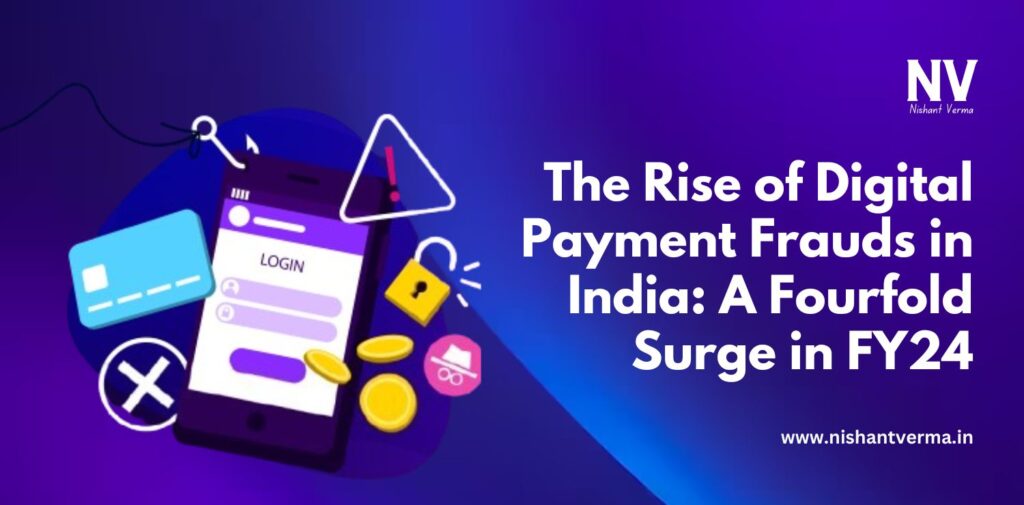In recent years, India has made significant strides towards a cashless economy, driven by the rapid adoption of digital payment systems. With the convenience of online banking, UPI (Unified Payments Interface), mobile wallets, and other digital payment methods, consumers are increasingly relying on technology to manage their finances. However, alongside this digital revolution comes a growing concern—digital payment fraud. According to recent data, digital payment fraud in India rose from 9,046 cases in FY23 to a staggering 36,075 in FY24, marking a fourfold increase in just one year. This alarming trend highlights the challenges that accompany the country’s march towards a digital economy.
The Surge in Digital Payment Fraud
The jump in fraud cases can be attributed to several factors. Firstly, the growing use of digital payment platforms has provided fraudsters with more opportunities to exploit weaknesses in the system. As more people embrace digital transactions, especially in the wake of government initiatives like Digital India, cybercriminals are devising increasingly sophisticated methods to defraud unsuspecting users.

Between FY23 and FY24, the number of digital payment frauds has multiplied, bringing into focus the vulnerabilities within the system. The sheer volume of transactions, combined with inadequate digital literacy among a significant portion of the population, has created a fertile ground for fraudsters to operate. Many users remain unaware of the risks associated with online payments, and this lack of awareness is being ruthlessly exploited by cybercriminals.
Factors Contributing to the Spike in Digital Payment Frauds
Increased Adoption of Digital Payments: The COVID-19 pandemic accelerated the shift towards digital payments, as lockdowns and social distancing measures forced individuals and businesses to avoid physical cash transactions. Platforms like UPI saw unprecedented growth, with billions of transactions taking place each month. This widespread adoption, while boosting convenience and transparency, has also increased the potential for cyber fraud. As digital payments become the norm, fraudsters have more avenues to exploit weak security measures.
Social Engineering Attacks: Social engineering, where fraudsters manipulate individuals into divulging personal information, has been one of the most prevalent methods of digital payment fraud. Tactics like phishing, smishing (SMS phishing), and vishing (voice phishing) have surged in recent years. Fraudsters use fake websites, text messages, or phone calls to trick users into sharing sensitive information like OTPs (One-Time Passwords), PINs, or bank details. In FY24, such attacks accounted for a significant portion of the reported frauds.
Weak Cybersecurity Measures: Another factor contributing to the rise in digital payment fraud is inadequate cybersecurity infrastructure. While digital platforms have implemented security measures such as two-factor authentication and encryption, these defenses are not foolproof. Cybercriminals have become adept at bypassing security protocols, especially on platforms that lack stringent controls. Additionally, small businesses and individuals often use outdated software or weak passwords, making them easy targets.
Lack of Digital Literacy: Despite the government’s push for digital literacy, a considerable portion of the population remains unaware of the risks associated with online transactions. Many users, especially in rural and semi-urban areas, do not understand basic online safety practices, such as not sharing OTPs, PINs, or passwords with anyone. This knowledge gap has made them prime targets for fraudsters.
Inadequate Legal and Regulatory Framework: While India has made strides in implementing regulations to combat cybercrime, enforcement remains a challenge. The existing legal framework often struggles to keep up with the fast-evolving methods used by cybercriminals. Additionally, the investigative processes can be slow, making it difficult to catch and prosecute fraudsters promptly. This has emboldened cybercriminals, knowing that they can often evade punishment.
Types of Digital Payment Frauds
Digital payment frauds have taken on various forms, and understanding them is crucial in mitigating the risks. Some of the most common types include:
Phishing and Smishing: Fraudsters send fake emails or SMS messages that appear to be from legitimate financial institutions, luring users into sharing their sensitive details.
Card Skimming: Skimming devices are installed on ATMs or point-of-sale (POS) systems to steal card information, which is then used for unauthorized transactions.

SIM-Swap Fraud: In this method, fraudsters impersonate a victim to gain access to their SIM card, allowing them to intercept OTPs and other authentication messages needed to conduct digital transactions.
Fake Payment Apps: Fraudsters develop counterfeit apps that mimic legitimate payment platforms, tricking users into entering their financial details, which are then stolen.
Malware Attacks: Cybercriminals use malware to infect devices, enabling them to steal sensitive information or take control of the device, facilitating fraudulent transactions.
Government Initiatives and Industry Responses
Recognizing the gravity of the situation, the Indian government, along with regulatory bodies like the Reserve Bank of India (RBI), has taken several steps to mitigate the risk of digital payment fraud. The RBI has mandated stricter regulations for banks and payment service providers, including stronger KYC (Know Your Customer) norms, transaction monitoring, and customer education initiatives.
The government has also launched various digital literacy programs to educate citizens about online safety practices. However, these efforts have not been enough to stem the tide of fraud. More needs to be done to enhance public awareness, particularly in rural and semi-urban areas, where digital literacy levels are low.
Preventive Measures for Consumers
While the government and the banking industry play a crucial role in securing digital payments, consumers also need to take proactive steps to protect themselves. Some basic precautions include:

Never Share Sensitive Information: Users should avoid sharing OTPs, passwords, or personal identification numbers (PINs) with anyone, even if they claim to be from the bank.
Enable Two-Factor Authentication: Most payment platforms offer two-factor authentication, which adds an extra layer of security.
Use Trusted Payment Platforms: Consumers should stick to well-known and trusted payment apps and avoid downloading apps from third-party sources.
Keep Software Updated: Regularly updating banking apps and other financial software ensures that users have the latest security patches.
Monitor Bank Statements: Regularly checking bank statements for unauthorized transactions can help detect fraud early.
Conclusion
The sharp increase in digital payment frauds from FY23 to FY24 is a stark reminder that as India advances towards a cashless economy, the risks of cybercrime are also growing. While the convenience of digital transactions cannot be denied, both consumers and institutions must stay vigilant and take proactive steps to secure their financial data. Strengthening cybersecurity measures, raising public awareness, and enforcing stricter regulations are essential to curbing the menace of digital payment fraud in the country.
By fostering a culture of digital literacy and cybersecurity awareness, India can continue to embrace the digital revolution while safeguarding its citizens from the threats that come with it.




